Posts Tagged: birds
A More Humane and Non-Toxic Pest Repellant
Once my husband and I had gotten the upper hand on preventing spotted-wing fruit flies from ruining our delicious Lapin cherries, we still had the problem of birds chowing down on them. In previous years, we had covered the tree with bird netting, but needless to say this was always a difficult procedure – both putting it up and taking it down. The bigger negative was that more than one bird got caught in the net…a traumatic experience for all concerned!
So one day while driving through the wine country and observing the balloon-like oddities suspended above the rows of grapes, inspiration struck! The balls had “evil eyes” printed on them and they were moving in the breeze. Putting two and two together: I had previously been advised by Gary Bogue (retired wildlife columnist for the Contra Costa Times) that hanging a yellow smiley-face balloon in the almond tree would keep squirrels at bay. The problem was that the balloons, though seemingly effective for a time, eventually ran out of gas, faded and got stuck in the tree.
We came up with our own solution: a volleyball which we painted with an “evil eye” on each side. It was suspended just above the tree top via a PVC pipe and Voilà! Out of 60 pounds of cherries, about a dozen of them had bird pecks , and these came from the lower branches where I suppose the eye wasn’t visible.
Later in the summer, we hung the volleyball eye above our almond tree and it seemed to keep the squirrel away as well. Our squirrel-crazed bird dogs alerted us every time it hit our neighbors’ almond tree…maybe that had something to do with it too.
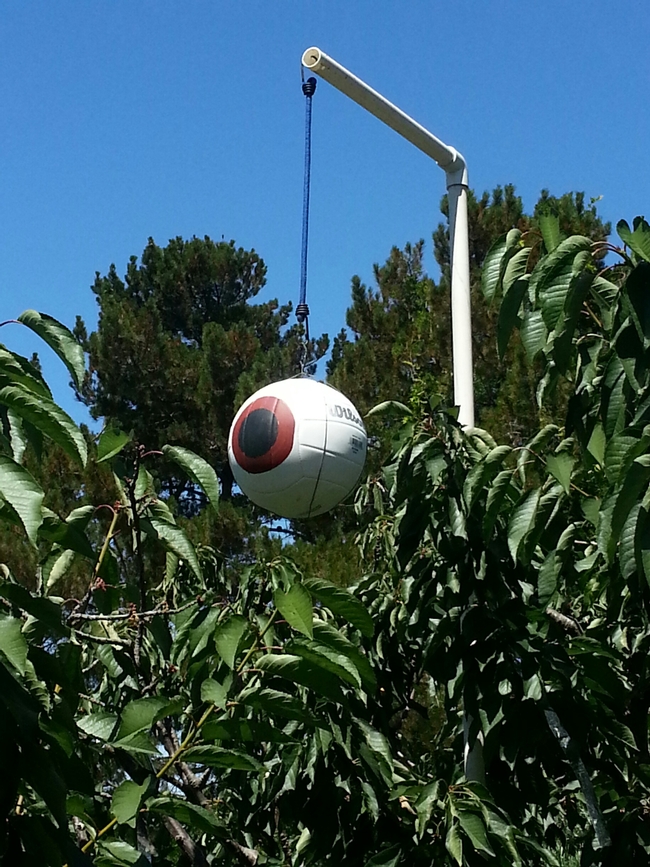
The evil eye! (photo by Donna Seslar)
Plants for Clay Soil and Other Things
Today while going through my e-mail, one of them really caught my eye. It was the monthly newsletter from BIRDS & BLOOMS, a magazine dedicated to those who both garden and bird-watch. I first came across this magazine when my mother, who subscribed, gave me her copies. I always thought of it as one of those publications for the “older set” and didn’t give it much thought. After mom passed, the subscription still had 3 years left, so I kept getting it. The more I read it, the more interesting this magazine became!
So here it is 2013 and now I have my own subscription that is complimented by this monthly on-line feature. Sometimes the features are on target and other times they are not –when not, it’s usually big time: articles that pertain to the Mid West only.
Imagine my surprise when the topic for this month is “Plants for Clay Soil”. I had to read the article thoroughly in case it held nuggets of wisdom I should -- nay, must have! I feel better now, since most of the plants listed are in my yard! Asters were the first on their list (which is only correct as these plants are listed alphabetically). Not only it common name; botanical name (a real plus when you are actually looking for the listed plants!); hardiness, bloom season; size ( that’s another big plus to the list); flowers, both colors and shape; light needs; growing advice (this is necessarily somewhat vague when you consider that this advice is trying to cover the entire USA, but you can tweak it according to where you happen to be); and, finally, what is called the “prize picks” or listing of what the editors consider to be the best variety.
Of the plants selected, I have the day lily (hemerocallis), switchgrass (Panicum virgatum) Viburnum (Viburnum sps), and various ferns including the squirrel’s foot fern (Polypodiumspp.), which hangs from a piece of all-thread screwed into the pergola . Potentilla (Potentilla fruitcosa) is a favorite as a small ground cover in the side yard, running into the baby’s tears (Soleirolia soleirolii).
The entire list is Aster, Black-eyed Susan, Coreopsis, Daylily, Ferns, Japanese Iris (mine died a very painful death, at least to my wallet), Runner bean, Switchgrass, Potentilla, and Viburnum. How many do you have in your yard?
PS: To those of you who noticed that the Switchgrass was listed before the Potentilla, it’s because using botanical names, Panicum comes before Potentilla!
Now to go and unwrap and plant my new rose from Vintage Gardens. The last sale – until the management announces another release before they go out of business for good!
PPS: I guess I have joined the “older set”!
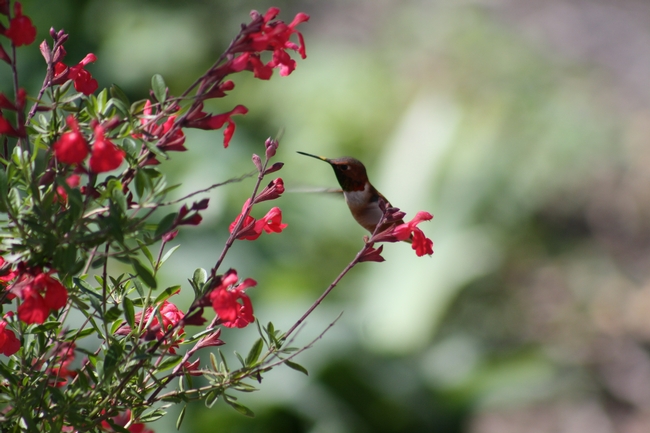
Rufous hummingbird visiting a 'Lipstick' sage. (photo by Jennifer Baumbach)
For the Birds
Doing monthly maintenance at the Children’s Memorial Garden in Fairfield has been more enjoyment than labor. The volunteer Master Gardeners who participate, show up early on the appointed day, with their tools, always eager to begin the task at hand. Everyone finds a job from weeding, deadheading, raking leaves and removing debris. Often we talk and share plant information or discuss upcoming Master Gardener events. Occasionally, in silence, we listen to the hum of bees and observe dragonflies and damselflies as they zoom in and out between the plants. Earlier this year, we observed a crow and heard a meadowlark in the magnolia and arbutus trees behind the little garden.
It was listening to the sounds of the garden that gave me an idea. Why not add a birdhouse on a pole to the garden. It might become a home for the birds and would be a delight to the adults and children who pass by daily. My husband and I had a rustic birdhouse that was embellished with a western motif (metal horse head, stars and horseshoe). The pole we envisioned was something natural, not something perfect or man-made. When we found a seven foot long tree branch in the alley behind our house, it was exactly what we were searching for. After removing most of the branches and cleaning the trunk, the birdhouse was attached to the pole with glue and screws. One weekend we took the birdhouse on the branch to the Children’s Garden and dug a two foot hole to place and stabilize the pole. Not many people notice this addition as it blends into the garden like it has always been there.
As of this writing, there are no new residents in the birdhouse. Maybe the birds are unsure of the horse head significance on their potential nesting home. The birdhouse is standing guard over this tiny garden the Master Gardeners planted in memory of the children of Solano County who have passed away.
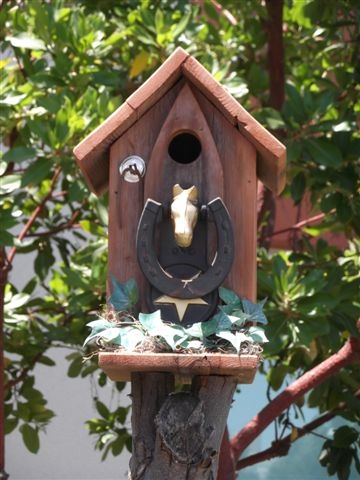
Entrance to the bird house. (photos by Sharon Rico)
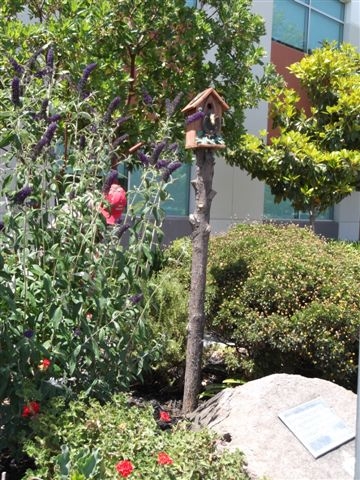
Bird house on a branch (pole).
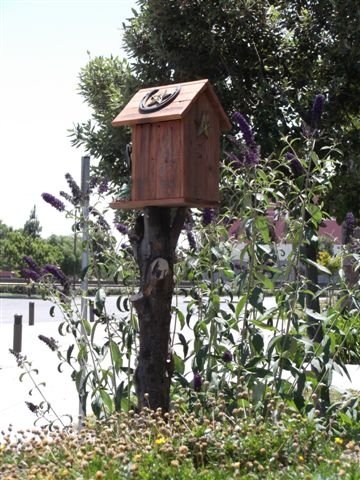
;lk;ljasfd
Good Morning to You
Cool, sunny spring mornings bring a visual and aural symphony to my neighborhood. Just the other day, I saw and heard this variety of fine-feathered friends in and around our yard:
- Harsh, assertive yet beautiful scrub jays. I can usually find my cat by following the yelling scrub jays.
- Twitchy, flighty but amazingly versatile mockingbirds. We have the world’s loneliest mockingbird in our area. He goes through his repertoire of songs 24/7, in hopes of finding a mate. Alas, no luck yet.
- Lovely, perfectly named mourning doves, always in a pair. Their coordinated flights are graceful yet pensive.
- Pert and perky finches and sparrows, arguing over a cache of ants or seeds.
- Chatty, glossy black and super smart crows and ravens. They do sky-high battle with the owls and hawks. Quite a sight.
- Acrobatic nuthatches, defying gravity by turning sideways and upside down on vertical surfaces as they forage.
- Hummingbirds of all kinds, glittering in the sun while they forage at the salvias. I have had hummers stop by the business end of my hose, just 2 feet away from my hand, as I water out back. What a gift! Stunning little creatures.
- Hawks, mostly red-taileds, riding the thermals and screaming their primeval cries. They often cruise by our chicken run, always hopeful of a quick fly-thru meal.
- California quail — lots of quail — sending out a sentinel, then the covey emerging, crossing the street and setting up shop in the shrubs. There’s a daily commute, across our street in the morning, then a return trip around dusk.
I am not a birder, but I sure do enjoy watching the local winged wonders. What about your yard? If it’s devoid of chirps and screeches, perhaps you need to put in some bird-friendly landscaping. This guide offers plenty of suggestions to get you started, if you’re closer to the Bay. Here’s another that is more specific to the Sacramento Valley.
I know birds can be voracious pests to backyard gardeners, especially if you’re growing fruits or nuts. Heck, we had to build Fort Knox-like frames of bird netting for our raised beds in order to protect our tomatoes. This publication is full of good ideas to keep the birds away from your future harvest.
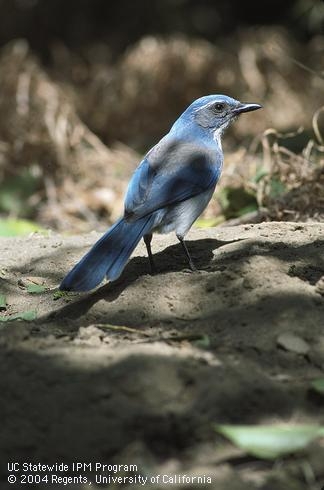
Noisy scrub jays thrive throughout California. They can be aggressive pests, but are lovely to look at. (photo by Jack Kelly Clark, UC Statewide IPM Program)
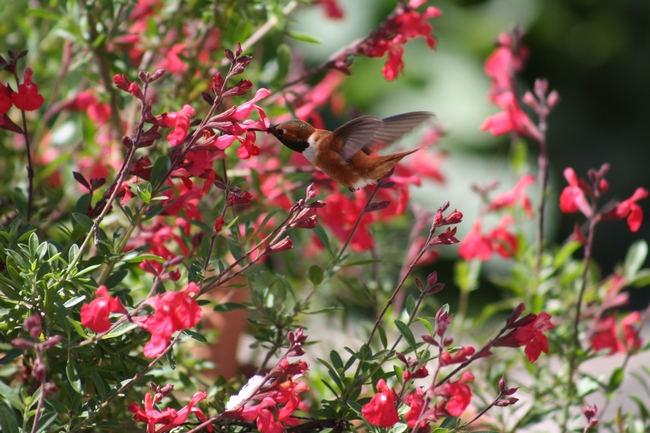
Rufous hummingbird visiting a 'Lipstick' sage. (photo by Jennifer Baumbach)
Success with Holly Trees
I've always loved holly especially around Christmas time. I once hand carried a holly wreath home on an airplane after a trip to Seattle. Not wanting to do that too often, I decided I would have to get a holly tree. I found I would need two trees a male and a female if I wanted berries. My local nursery kindly ordered them for me. (Note this was at least a decade ago).
These being my pre- Master Gardener days, I am not sure what variety of holly I have. I suspect it is either Ilex aquifolium, English Holly, or an English Holly cross breed. I put them promptly into containers where they languished for the next several years. I finally decided I had to do something so I transplanted them into the ground in my side yard.
Both trees perked up immediately. The male tree which got put in the shadier spot is about three feet tall. The female who ended up in the sunnier spot shot up to five feet. Over the past year or two I was able to pick some sprigs to put into arrangements, but I was afraid to cut too much and didn't have many berries.
This year the female tree has exploded with berries. I even cut enough branches to make my own small holly wreath. (I now realize why we don't use holly at the wreath workshop, you need major protection for dealing with those spines.)
I've been trying to watch the berries, but I haven't seen any birds eating them yet. One Internet source suggested that the berries needed a few freezes to soften. I am going to continue to watch and will see what happens. Robins and mockingbirds are supposed to like them.
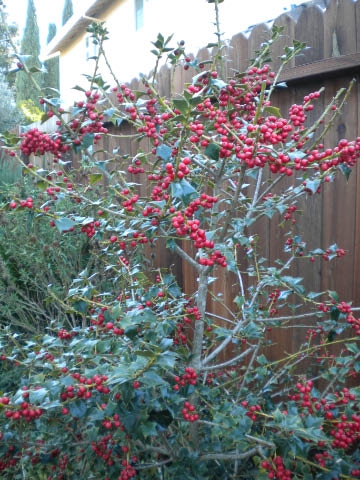
DSCN2422
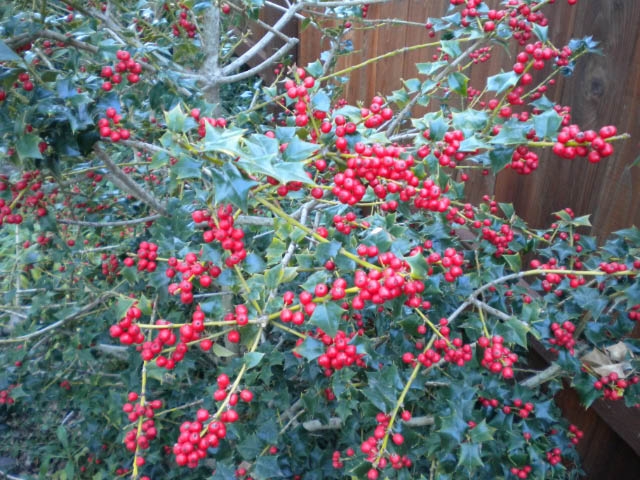
photos by Karen Metz

